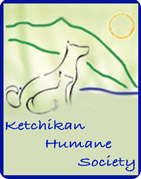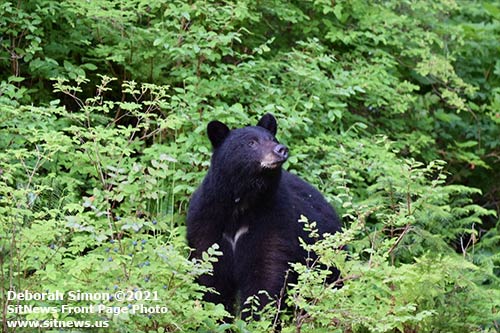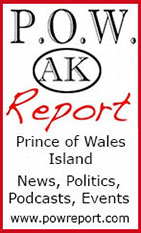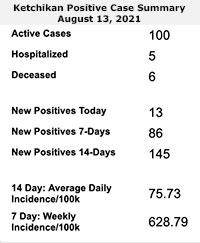








 Contact Contact 
 Webmail
Letters Webmail
Letters
 News Tips News Tips
 Copyright Info Copyright Info
 Archives Archives
Quick News
Search
 Alaska Alaska
 Ketchikan Ketchikan
 SE Alaska SE Alaska
Columns
- Articles
 Dave Kiffer Dave Kiffer
 Money Matters Money Matters
Historical
Ketchikan
 June Allen June Allen
 Dave
Kiffer Dave
Kiffer
 Louise
B. Harrington Louise
B. Harrington
Sports
 Ketchikan Links Ketchikan Links
Public Records
 FAA Accident Reports FAA Accident Reports
 NTSB
Accident Reports NTSB
Accident Reports
 Court Calendar Court Calendar
 Recent Filings & Case Dispositions Recent Filings & Case Dispositions
 Court Records Search Court Records Search
 Sex Offender Reg. Sex Offender Reg.
 Public Notices Public Notices
 Alaska Recall Alerts Alaska Recall Alerts
 Recalls.gov Recalls.gov
 AST Daily Dispatch AST Daily Dispatch
 KTN
Police Reports KTN
Police Reports
 Juneau Police Reports Juneau Police Reports
Weather,
Webcams
 Today's
Forecast Today's
Forecast
 KTN
Weather Data KTN
Weather Data
 AK
Weather Map AK
Weather Map
 AK Weathercams AK Weathercams
 AK Earthquakes AK Earthquakes

|
|

Saturday
August 14, 2021

Black Bear
This momma bear keeps her eye on two cubs in the cove area. She is looking up at one of her cubs who climbed a tree.
SitNews Front Page Photo by DEBORAH SIMON ©2021
To have your photo(s) featured on the front page,
email your photo(s) to editor@sitnews.us |
|
Ketchikan Historical: Gravina: A Tale of Two Islands By DAVE KIFFER
- Considering that Ketchikan residents spend a lot of time staring across Tongass Narrows at Gravina Island, there is a lot that most people don't know about it.
Yes, we take the airport ferry and we fly out from the airport. Maybe we have driven to the end of the "Road to Nowhere" or we have gone deer hunting on High Mountain. Residents of a certain age still talk fondly of the community picnics at Black Sands Beach.
But in general, for most area residents, Gravina is a like a prop to Ketchikan. Something to stare at on a sunny day, but not much else.
Of course, there is more to Gravina than that.
For example, did you know that Gravina is two different islands? Well, not now, but it used to be.
First off, there are three distinct parts to Gravina that are all geologically separate, according to the 1973 federal report "Geology of Gravina Island, Alaska."
There is the eastern side, which is similar to the geology of Revillagigedo Island. Then there is a lowlands that extends from Bostwick Inlet all the way to Valenaar Bay. Then there is the western part of the island which has more in common with both Annette Island and Prince of Wales geologically. At some point, say in the late Triassic or early Jurassic periods, what we now know as Gravina was part of two separate land masses that only later drifted together as the continental plates moved.
And even after that happened, there was a time when the two sides separated again as rising ocean levels between ice ages flooded the lowlands from Bostwick to Valenar. That is why that area has a significant amount of ocean silt that was deposited millions of years ago.
Of course, the entire island was buried under glaciers during the last ice age, as was most of the region, which explains the generally rounded nature of the mountains of Gravina, according to the 1973 federal report.
The report goes into great detail about the island, even explaining why, like Revilla, it looks like it would have lots of gold and silver ore (hundreds of quartz veins) but despite dozens of mining attempts over the years, not much gold has been found.
Of course, there is much more to Gravina than its ore lodes, or relative lack thereof. The human history of Ketchikan's neighbor is as long as Ketchikan's when you start to look into it.
Historically, Taanta Kwaan Tlingits had summer fish camps on the island but no permanent settlements. When the Spanish explorer Jacinto Caamano passed through area in 1792 he named the area the " Gravina Islands" in honor of Spanish naval officer Federico Carlos Gravina y Napoli. When English explorer Capt. George Vancouver surveyed the area in 1793, he applied the Gravina name to the single island.
Gravina Island is roughly 21 miles long by nine miles wide. Let's start at Gravina Point, which is across from the southeastern tip of Pennock Island.
Ketchikan historian Pat Roppel published "An Historical Guide to Revillagigedo and Gravina Islands Alaska" in 1995 and most of the following information comes from that source.
Many of the coves and bays on the island were initially explored in the 1890s and 1900s as residents came looking for gold and silver. There was even a brief "oil rush" in 1910 when Jim Bratstone - who had oil experience in Wyoming and Texas - claimed to have found oil near Nelson Cove, but that quickly petered out when no one else could confirm his findings.
Gravina Point was the location of "Snag Harbor" which was the site of a homestead in the 1910s, but it is much for famous for an incident on August 9, 1994, when the Holland America cruise ship Nieuw Amsterdam ran aground in heavy fog at 6:20 am. The ship was refloated at 7:20 am and returned to Seattle. None of the 1,200 passengers or 500 crew members were injured, but the ship sustained more than $2 million damage to its hull.
The islands of Blank Inlet were the site of several fox farms when that industry swept through Alaska in the 1920s and 1930s and Black Sand Beach was a very popular location from at least 1915 through the early 1960s. Cannery scows would be used to ferry hundreds of residents to beach which had warmer water because the dark colored sand trapped more heat. There is now a state marine park encompassing the area around the beach and the borough has plans for a trail to the beach from the end of the South Gravina Highway (the Road to Nowhere).
Blank Point, at the mouth of Blank Inlet was also a popular location for moonshining back in the prohibition days with multiple stills operating, at least until the authorities shut them down.
Bostwick Inlet is the next big indent on Gravina and as noted above, it is part of a lowland that splits the island in two all the way to Valenar in the north. It was a popular place for cabins in the early years and also area that has peaked interest of miners because of visible quartz veins in the hillsides. Bostwick has also been a key crabbing site for locals for decades.
Just beyond Bostwick is Seal Cove where prospectors found enough copper to open up a mine in 1899 and mine the area until copper prices collapsed in World War I. Leading early Ketchikan citizens H.C, Strong and O.W. Grant were involved those efforts. There was also a very well- known incident in 1900 when a crew at the mine tried to thaw some frozen sticks of dynamite on a stove. The explosion killed one and seriously wounded three others. - More...
Saturday PM - August 14, 2021
|
|
Fish Factor: LED Lights on Gillnets Reducing Bycatch; More COVID Funds; & Fish Board Lineup By LAINE WELCH - Bycatch gives Alaska’s otherwise stellar fisheries management its biggest black eye.
The term refers to unwanted sea creatures taken in trawls, pots, lines and nets when boats are going after other targeted catches. Bycatch is the bane of existence for fishermen, seafood companies and policy makers alike, yet few significant advances have been found to mitigate the problem.
A simple fix has recently shed light on a solution.
“Ten underwater LED lights can be configured to light up different parts of the fishing gear with six different colors, intensity and flash rates to attract, repel or guide fish through the gear while retaining the target catches,” said Dan Watson, CEO and co-founder of SafetyNet Technologies based in the U.K which provides its Pisces light system to fisheries around the globe.
“The different light characteristics affect different species in different ways,” he added. “For instance, green light is really effective for reducing turtle bycatch in gillnets. Blue lights flashing at a particular rate can deter haddock and drive them away. This programmability means that you can use it for a number of different species and in different circumstances as well.”
The Pisces lights are powered by a wireless charger, require no plugs or batteries, automatically turn on underwater only when needed, and they do not weaken or weigh down nets.
Watson began working on the lights in 2009 when he was a student at Glasgow University and doing research with the Aberdeen Marine Laboratory.
“They had a paper that had been in their library for about 40 years from a researcher who had been shining flashlights into fish tanks and seeing that some species would react quite strongly, some would come towards them, some would move away, and others just weren't bothered at all,” he said.
After working in partnership with scientists and fishermen, the first batch of Pisces lights was tested in 2015 in fisheries in Europe and the and usage has since spread to the U.S. and other regions.
A 2015-2018 study on small-scale fishing vessels in Peru, for example, showed that LED lights on gillnets reduced bycatch of sea turtles in gillnet fisheries by more than 70% and over 66% for dolphins and porpoises, while not reducing the take of target species. The lights also reduced bycatch of seabirds in gillnets by about 85%.
The study, by the University of Exeter and the conservation organization ProDelphinus, concluded that "Sensory cues - in this case LED lights - are one way we might alert such species to the presence of fishing gear in the water.”
In the scallop fishery in the Irish Sea, use of Pisces lights reduced bycatch of haddock by 47% and flatfish by 25% with no effects on the take of scallops.
A 2020 study by Mark Lomeli of the Pacific States Marine Fisheries Commission in collaboration with the Northwest Fisheries Science Center showed that lights directed Chinook salmon to escape panels in trawl nets in the Pacific hake fishery, the largest groundfish fishery on the West Coast. Eighty-six percent of escaped Chinook used the well-lit, LED-framed openings and the data suggest the lights can increase salmon escapes overall.
And since 2018, the Oregon Fish and Wildlife Commission has required the use of lighting devices on the footropes of shrimp trawls. Sea trials showed that bycatch of eulachon was reduced by over 90% by weight, juvenile rockfish takes dropped by 78%, flatfish bycatch was reduced by nearly 70% and the loss of targeted shrimp was statistically non-significant at 0.7%.
“You don’t need the lights to cover the entire panel on a massive net, it might be that you put them along the foot rope or the headline or even potentially in the wings,” Watson explained. “We generally supply fishing vessels with around 10 lights and a couple of charging cases to keep them going. Rather than hundreds of lines, we're talking in the order of 10s, so that you can cover a sufficient area in the right place for it to be effective.”
Watson believes the lights will eventually be mandated in other fisheries around the world.
“In Europe we're working with agencies to try and get the required scientific evidence for them to start to legislate the use of lights,” he said. “It's still sort of in the early days in that respect despite really compelling results since 2015. It takes a while to get into that adoption phase and that's where we're working at the moment.”
“I think the fishing sector has a massive part to play and how it's shaped and actually introduced,” Watson added. “We're increasingly seeing that as technology is being developed and becoming more accessible, fishing crews are coming up with really great ideas to change how their fisheries are operating, and working collaboratively with science as well.”
Since May, the SafetyNet Tech team has been collaborating with the Alaska Ocean Cluster, (AOC) a project of the Bering Sea Fishermen’s Association, to identify captains and vessel owners interested in bringing the light show to Alaska, particularly aboard Bering Sea trawlers.
“They're an amazing representative for us in Alaska, because not only can they help us learn more about the fishing industry there but introduce us to people and start those relationships going,” Watson said. “It's kind of like having two extra people on our team, which is amazing when you're a startup because we're always looking for extra support and they've definitely offered it.”
"SNTech is a great example of the opportunities we're seeing across the seafood and marine technology landscape," said Garrett Evridge, AOC managing director of research and administration.
Taylor Holshouser, AOC managing director of business development, echoed that enthusiasm adding, “We're excited to see what Dan and his team can do to help fishermen reduce fuel costs, save time, and reduce bycatch, particularly in the Bering Sea." - More...
Saturday PM - August 14, 2021
|
|
Alaska: Alaska Redistricting Board Announces Next Steps - Thursday the Alaska Redistricting Board received legacy-formatted PL 94-171 Redistricting data electronically from the United States Census Bureau.
"We are excited to finally have numbers from the 2020 Census” said John Binkley, Chair of the Alaska Redistricting Board. “Our staff are working with experts at the Department of Labor to import the data so we can begin the work of drawing new Alaska legislative districts as soon as possible.”
“Alaska’s Constitutional redistricting cycle is fast-paced and we intend to dive right in,” said Board Member Nicole Borromeo. “After so many months of pandemic-driven delay, we are eager to begin drawing new districts for Alaska voters.”
On September 30, the US Census Bureau will deliver official, user-friendly redistricting data via courier to key state officials, including the Redistricting Board, on fixed DVD media. Until then, Board staff are working with electronically provided legacy-formatted data from the US Census Bureau provided in a collection of large plaintext files which require extensive conversion to be usable. - More...
Saturday PM - August 14, 2021
Alaska: Detection and analysis phase of cyberattack response complete; vital records section back online, working through backlog - The Alaska Department of Health and Social Services (DHSS) recently announced the department has completed the first step of a three-step process used to respond to the attack of its information technology infrastructure. With the completion of the detection and analysis phase, DHSS’ security partners have identified those responsible for conducting the attack as a highly sophisticated group known to conduct complex cyberattacks against organizations such as state governments and health care entities.
Shortly after the attack was discovered in May, DHSS retained FireEye, a leading cybersecurity firm that provides incident response consulting services through Mandiant, to help conduct an in-depth investigation and assist with the recovery process. At this time, the investigation has found no indications that this was a ransomware attack and there is no current evidence that Alaskans’ protected health information or personally identifiable information was stolen.
“The type of group behind this disruptive attack is a very serious operation with advanced capabilities,” said Commissioner Adam Crum. “DHSS is intensely focused on responding to the attack and we continue to work with our security partners and the state Office of Information Technology to restore services as quickly and safely as possible.”
“This was not a ‘one-and-done’ situation, but rather a sophisticated attack intended to be carried out undetected over a prolonged period. The attackers took steps to maintain that long-term access even after they were detected,” said DHSS Technology Officer Scott McCutcheon. “In addition to getting everything back up and running, our team is taking strong, preventative actions and developing more robust incident response capabilities so we can quickly respond to any future cyberattacks.”
DHSS is focused on continuing through the three steps of its response: - More...
Saturday PM - August 14, 2021
|
|
Ketchikan: New Manager of PeaceHealth Ketchikan Medical Center Foundation Announced - PeaceHealth Northwest network Chief Development Officer Anne Rasmussen announced recently, that Marie Lindelli will assume local leadership of the PeaceHealth Ketchikan Medical Center Foundation on August 30, 2021.
As Foundation manager, Lindelli will direct major fundraising operations and build on partnerships with businesses and people in the community that inspired projects like the Pinky Brindle Cancer Resource Center and the Ken Eichner Healing Garden. Lindelli will work closely with PeaceHealth Ketchikan, the Foundation board and the community to assess needs and fundraise for projects deemed critical to the wellness of our community.
Lindelli arrived in Ketchikan a little over a year ago, most recently working for the University of Alaska building relationships and managing projects. Lindelli has embraced living in Ketchikan sharing, “the city and its people have already captured my heart, and I love living here.” Before moving to Ketchikan, Lindelli worked in client success services that included event planning and capital giving campaigns.
Lindelli ’s extensive background in community and client collaboration make her well-suited to lead the Foundation’s efforts at the local level. She has managed more than 60 accounts as a client success consultant with BELAY Solutions in Atlanta, GA, and in a previous role as Director of Client Services for Generis in Johns Creek, GA, Lindelli helped build fundraising forecasts and manage capital campaigns for over 20 clients. - More...
Saturday PM - August 14, 2021
Alaska: Alaska Power & Telephone Offers Tribal Broadband Affordability Program - Alaska Power & Telephone Company recently announced it has established a Tribal Broadband Affordability Program for tribes in its service areas that wish to establish affordable telecommunications services for their members. The AP&T program is specifically intended to interface with and support the objectives of the National Telecommunications and Infrastructure Administrative (NTIA) Tribal Broadband Connectivity Program. (CDFA 11.029, Tribal Broadband Connectivity Program.)
Through the NTIA program, which closes August 30th, tribes are eligible for $2.5m each for programs with services “such as providing free or reduced-cost broadband service and preventing disconnection of existing broadband service.” AP&T’s Tribal Broadband Affordability Program provides an option whereby tribes can utilize NTIA or other grants or funds to pre-purchase vouchers for multiple years of service for tribal members.
AP&T CEO Mike Garrett remarked: “AP&T is honored to have the opportunity to provide services to tribes and their members, and to support self-determination objectives. Tribal populations strengthen our services areas and our company through their cultural perspective and traditional knowledge. Additionally, tribes provide critical community services to their members and beyond, and drive rural economic development. We are hopeful that AP&T’s Tribal Broadband Affordability Program will empower tribes to utilize NTIA funds to strengthen tribal members’ access to telecommunications services, despite the limited time available to apply for funds.” - More...
Saturday PM - August 14, 2021 |
|
Analysis: What is Section 230? An expert on internet law and regulation explains the legislation that paved the way for Facebook, Google and Twitter By ABBEY STEMLER - Almost any article you read about Section 230 reminds you that it contains the most important 26 words in tech and that it is the law that made the modern internet. This is all true, but Section 230 is also the most significant obstacle to stopping misinformation online.
Section 230 is part of the Communications Decency Act, a 1996 law passed while the internet was still embryonic and downright terrifying to some lawmakers for what it could unleash, particularly with regard to pornography.
Section 230 states that internet platforms — dubbed “interactive computer services” in the statute — cannot be treated as publishers or speakers of content provided by their users. This means that just about anything a user posts on a platform’s website will not create legal liability for the platform, even if the post is defamatory, dangerous, abhorrent or otherwise unlawful. This includes encouraging terrorism, promoting dangerous medical misinformation and engaging in revenge porn.
Platforms, including today’s social media giants Facebook, Twitter and Google, therefore have complete control over what information Americans see.
How Section 230 came to be
The Communications Decency Act was the brainchild of Sen. James Exon, Democrat of Nebraska, who wanted to remove and prevent “filth” on the internet. Because of its overreaching nature, much of the law was struck down on First Amendment grounds shortly after the act’s passage. Ironically, what remains is the provision that allowed filth and other truly damaging content to metastasize on the internet.
Section 230’s inclusion in the CDA was a last-ditch effort by then Rep. Ron Wyden, Democrat of Oregon, and Rep. Chris Cox, Republican of California, to save the nascent internet and its economic potential. They were deeply concerned by a 1995 case that found Prodigy, an online bulletin board operator, liable for a defamatory post by one of its users because Prodigy lightly moderated user content. Wyden and Cox wanted to preempt the court’s decision with Section 230. Without it, platforms would face a Hobson’s choice: If they did anything to moderate user content, they would be held liable for that content, and if they did nothing, who knew what unchecked horrors would be released. - More...
Saturday PM - August 14, 2021
|

Study takes unprecedented peek into life of 17,000-year-old mammoth
By JEFF RICHARDSON
An adult male woolly mammoth navigates a mountain pass in Arctic Alaska 17,100 years ago. The image is produced from an original life-size painting by paleo artist James Havens. The painting is housed at the University of Alaska Museum of the North in Fairbanks.
Image by James Havens |
|
Alaska: Study takes unprecedented peek into life of 17,000-year-old mammoth By JEFF RICHARDSON - An international research team has retraced the astonishing lifetime journey of an Arctic woolly mammoth, which covered enough of the Alaska landscape during its 28 years to almost circle the Earth twice.
Scientists gathered unprecedented details of its life through analysis of a 17,000-year-old fossil from the University of Alaska Museum of the North. By generating and studying isotopic data in the mammoth’s tusk, they were able to match its movements and diet with isotopic maps of the region.
Few details have been known about the lives and movements of woolly mammoths, and the study offers the first evidence that they traveled vast distances. An outline of the mammoth’s life is detailed in the new issue of the journal Science.
“It’s not clear-cut if it was a seasonal migrator, but it covered some serious ground,” said University of Alaska Fairbanks researcher Matthew Wooller, senior and co-lead author of the paper. “It visited many parts of Alaska at some point during its lifetime, which is pretty amazing when you think about how big that area is.”
Researchers at the Alaska Stable Isotope Facility, where Wooller is director, split the 6-foot tusk lengthwise and generated about 400,000 microscopic data points using a laser and other techniques.
The detailed isotope analyses they made are possible because of the way that mammoth tusks grew. Mammoths steadily added new layers on a daily basis throughout their lives. When the tusk was split lengthwise for sampling, these growth bands looked like stacked ice cream cones, offering a chronological record of an entire mammoth’s life.
“From the moment they’re born until the day they die, they’ve got a diary and it’s written in their tusks,” said Pat Druckenmiller, a paleontologist and director of the UA Museum of the North. “Mother Nature doesn’t usually offer up such convenient and lifelong records of an individual’s life.”
Scientists knew that the mammoth died on Alaska’s North Slope above the Arctic Circle, where its remains were excavated by a team that included UAF’s Dan Mann and Pam Groves, who are among the co-authors of the study.
Researchers pieced together the mammoth’s journey up to that point by analyzing isotopic signatures in its tusk from the elements strontium and oxygen, which were matched with maps predicting isotope variations across Alaska. Researchers created the maps by analyzing the teeth of hundreds of small rodents from across Alaska held in the museum’s collections. The animals travel relatively small distances during their lifetimes and represent local isotope signals.
Using that local dataset, they mapped isotope variation across Alaska, providing a baseline to trace the mammoth movements. After taking geographic barriers into account and the average distance it traveled each week, researchers used a novel spatial modeling approach to chart the likely routes the animal took during its life.
Ancient DNA preserved in the mammoth’s remains allowed the team to identify it as a male that was related to the last group of its species living in mainland Alaska. Those details provided more insight into the animal’s life and behavior, said Beth Shapiro, who led the DNA component of the study. - More...
Saturday PM - August 14, 2021
|
DAVE KIFFER: Citius, Altius, Delugious! - Well, the Olympic are over for at least another year or so (kind of lost that quadrennial thing when they split up the summer and the winters ones).
Actually, I just read that the Beijing Winter Olympics are starting in six months. I. Am. So. Confused.
At any rate, I think I was one of only two people (based on the Nielson ratings) who actually managed to watch all the coverage on NBC's various "platforms."
Well, not entirely, there were some weird ones that were being posted directly into people's brains via hoof and mouth vaccinations that I decided to pass on (equestrian events are not my thing, see below). But I got nearly all the rest!
Speaking of which, just what the Hokkaido Heck is a "platform?" - More...
Saturday PM - August 14, 2021
FINANCIAL FOCUS: Review your IRA, 401(k) beneficiaries Provided By BEN EDWARDS, AAMS® - If you’ve had an IRA and a 401(k) for many years, you may occasionally ask yourself some questions: “Am I contributing enough?” “Am I still funding these accounts with the right mix of investments for my goals and risk tolerance?” But here’s one inquiry you might be overlooking: “Have I used the correct beneficiary designations?” And the answer you get is important.
It wouldn’t be surprising if you haven’t thought much about the beneficiary designation – after all, it was just something you once signed, possibly a long time ago. Is it really that big a deal?
It could be. For one thing, what if your family circumstances have changed since you named a beneficiary? If you’ve remarried, you may not want your former spouse to receive your IRA and 401(k) assets or the proceeds of your life insurance policy, for which you also named a beneficiary.
- More...
Saturday PM
-August 14, 2021 |
The Front-Page Test By Dan Bockhorst
- The Front-Page Test is a simple way to consider whether an action is ethical. The test involves answering the following question: If I took a particular action, how would I feel if details were reported on the front page of the local newspaper?
Now, apply the test to the circumstances described below. (The description is my opinion and belief.)
1. MISUSE OF PUBLIC RESOURCES. In April, the borough manager directed his staff to prepare an in-house compensation study exclusively for his position. The manager did so even though the borough had spent $65,000 for a consultant to conduct a compensation study for the manager’s position and those of all other borough employees. The purpose of the manager’s internal study was to gather information for the manager to negotiate a new employment contract. That was a misuse of public resources. The in-house study by the manager’s staff, funded by public monies, did not serve a public interest; it only served the manager’s private interests as an individual pursuing an employment contract with the borough.
2. STUDY USED DIFFERENT STANDARDS AND PROCEDURES. The manager’s internal study did not follow the same model used in the $65,000 consultant study. The internal study established an illusory benchmark for negotiation of the manager’s new contract. The study was not conducted at arm’s length. The in-house study examined salaries of the Ketchikan city manager and managers in 13 other communities throughout Alaska. However, there was no geographic adjustment for labor costs. Ten of the fourteen communities, including Nome, Aleutian Islands, Bethel, Bristol Bay, and Cordova had higher labor costs compared to Ketchikan; two were equal to Ketchikan, and two had lower costs. The $65,000 consultant study determined that the market parity for the manager was $154,900; however, that figure was not used in the manager’s in-house study. Yet, the in-house study included the $219,996 salary for the Ketchikan city manager. Also included was a comparison to a manager with 40 years’ experience. That comparison was heavily skewed because it didn’t take benefits into account (the in-house study ignored benefits for all comparisons). Based on the in-house study, the manager proposed an increase in his salary to $175,000 (a 23% increase) plus a 20% increase in paid time off. - More...
Saturday PM - August 14, 2021
 |
RE: Ketchikan Airport Ferry Service By Chris J. Herby
- I am writing as a follow up to my previous letter regarding our problems with access to our airport. I really hope that our Borough Assembly will realize the problem we have and begin the process of fixing it. After all, assembly members are elected to deal with these types of problems as well as do long range planning to hopefully avoid similar problems in the future.
I believe the short term fix is to budget a second airport ferry to operate during the busy summer months starting next summer. With reading recent reports about the trillion dollar infrastructure bill passed by congress, we may have a golden opportunity for a long term fix. If the enormous bill reaches final approval, there will be large amounts of money available for electric ferries. They will be targeted for short ferry routes. What better route for an electric ferry than our extremely short Tongass Narrows crossing to our airport. A new electric airport ferry could be constructed that could be larger and accommodate more passengers and vehicles thereby being able to handle the traffic with only one ferry running every 30 minutes. The ferry would be able to connect to power and re-charge all night every night. This seems like a perfect opportunity. Of course some infrastructure would have to be modified to accommodate a larger ferry and provide charging facilities. This could all be included in the federal funding. This whole process would certainly take several years to accomplish, but we should immediately begin exploring the possibility of this and try to be in the front of the line. - More...
Saturday PM - August 14, 2021
 |
Open Letter To Sen. Murkowski, Sen. Sullivan, Rep. Young, & Gov. Dunleavy By Michelle O’Brien, On behalf of the Board of Directors of the Ketchikan Chamber of Commerce - This letter is regarding Amendment 2186, filed by Senator Kirsten Gillibrand to the Senate's Infrastructure bill, which would require Commercial Drivers Licenses (CDL) for all commercial motor vehicles (CMV) designed to carry 9 to 15 passengers.
This amendment would be disastrous for the small companies which make up the majority of businesses within the Ketchikan Gateway Borough, Alaska. CDL driver positions are already among the most difficult positions to fill and regulations for insurance, drug testing, health clearance and license testing already complicate this process. The difference in wages between what a small business can pay for a CDL driver, driving a 15-passenger vehicle, also varies dramatically from what a trucking company can pay for driving a semi.
• Insurance: Many small businesses can only insure CDL operators after 1 year of CDL experience and minimum driving experience of 7 years. This automatically eliminates a large percentage of the young, often seasonal, workforce from these positions. It also prohibits many small companies from being able to hire an individual, with the intent of providing training, and being able to use this employee. - More...
Saturday PM - August 14, 2021
 |
CONFERENCE OF YOUNG ALASKANS
By Austin Otos
- I recently had the opportunity to attend the 2021 Conference of Young Alaskans (COYA) hosted by Alaska Municipal League (AML) in Fairbanks. 55 student delegates from around the State of Alaska traveled to Fairbanks to get a crash course in local government, resolution writing, and networking with other elected leaders from around the state. The conference was modeled off of the 55 delegates who crafted the Alaska State Constitution. The youth attendees crafted resolutions intended to be delivered to all mayors of Alaska. Each resolution focused on key issues that impact local government including: economic development, public safety, education, public utilities, energy, and public transportation. In order to craft the resolutions, the delegates were split into committees that focused on those core topics. After three days in committees the delegates crafted a resolution on each topic and presented it to the whole body to be voted on. This type of model is one of the more effective and traditional ways of lawmaking. The overall idea of the exercise was to show the delegates that it is more productive to divide tasks amongst members of a large governing body instead of getting bogged down in debate over the finer details.
Aside from resolution writing, the conference showed youth delegates the ins and outs of local government. Often, people have an idea of what local government does but don’t understand the more detailed tasks they do on a day-to- day basis. Workshops were set up to convey that local government is where a lot of the work is done when it comes to implementation of policy. A wide range of panelists sat in on the workshops from municipal employees, elected officials, non-profits, and for-profit entities, showcasing the large collaboration that local governments have with other community organizations. I ran a workshop called “local government fishbowl” where current local elected officials explained their connection to local government. Some of the questions posed to elected officials were: What draws you to local government?; How does state and federal government impact your decision-making?: and, How does the class of your borough or city impact what you do? I was able to explain some of the challenges that the Ketchikan Gateway Borough faces when it comes to new housing development because we lack road powers as a 2nd Class Borough. Understanding the limits of what a borough or city can or cannot do helps guide policy on what issues a local governing body can tackle. - More...
Saturday PM - August 14, 2021
Email letters, opinions, OPEDs to editor@sitnews.us
|
Articles &
photographs that appear in SitNews may be protected by copyright
and may not be reprinted or redistributed without written permission
from and payment of required fees to the proper sources.
E-mail your news &
photos to editor@sitnews.us
Photographers choosing to submit photographs for publication to SitNews are in doing so, granting their permission for publication and for archiving. SitNews does not sell photographs. All requests for purchasing a photograph will be emailed to the photographer.
|
|















|
|
![]() Contact
Contact ![]()
![]() Webmail
Letters
Webmail
Letters![]()
![]() News Tips
News Tips![]()
![]() Copyright Info
Copyright Info![]() Archives
Archives![]() Alaska
Alaska![]() Ketchikan
Ketchikan![]() SE Alaska
SE Alaska![]() Dave Kiffer
Dave Kiffer![]() Money Matters
Money Matters ![]() June Allen
June Allen![]() Dave
Kiffer
Dave
Kiffer![]() Louise
B. Harrington
Louise
B. Harrington ![]() Ketchikan Links
Ketchikan Links![]() FAA Accident Reports
FAA Accident Reports ![]() NTSB
Accident Reports
NTSB
Accident Reports![]() Court Calendar
Court Calendar![]() Recent Filings & Case Dispositions
Recent Filings & Case Dispositions ![]() Court Records Search
Court Records Search![]() Sex Offender Reg.
Sex Offender Reg.![]() Public Notices
Public Notices![]() Alaska Recall Alerts
Alaska Recall Alerts![]() Recalls.gov
Recalls.gov![]() AST Daily Dispatch
AST Daily Dispatch![]() KTN
Police Reports
KTN
Police Reports![]() Juneau Police Reports
Juneau Police Reports ![]() Today's
Forecast
Today's
Forecast![]() KTN
Weather Data
KTN
Weather Data![]() AK
Weather Map
AK
Weather Map![]() AK Weathercams
AK Weathercams![]() AK Earthquakes
AK Earthquakes
































